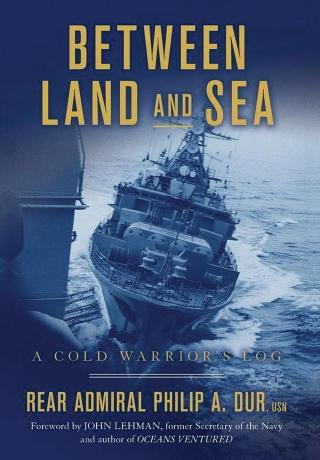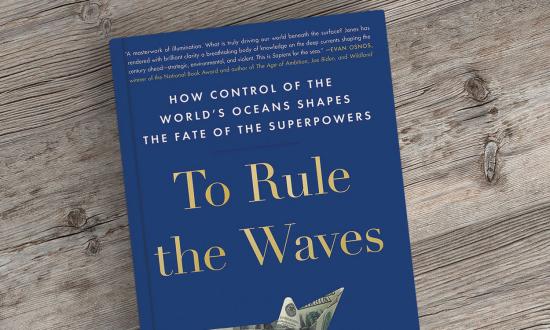Between Land and Sea: A Cold Warrior’s Log
Rear Admiral Philip Dur, U.S. Navy (Retired). Austin, TX: Lioncrest Publishing, 2022. 404 pp. Appx. Gloss. Index. $32.99.
Reviewed by Captain Don Donegan, U.S. Navy (Retired)
A poem from a French chapel is the inspiration for the title Between Land and Sea—Rear Admiral Phil Dur’s memoir of his 30-year naval career. He devotes equal time and detail describing challenges and opportunities during afloat and ashore tours amid the height of the Cold War and in the immediate aftermath of the Soviet Union’s collapse. His expertise gained both at sea and in influential staff positions throughout his career makes this memoir a valuable contribution to Cold War history.
Between Land and Sea will attract two principal groups of readers: those who experienced or study the Cold War and the U.S. Navy showdown with the Soviet Navy; and those thinkers trying to synthesize how the Navy can develop and foster a cadre of uniformed strategists. For readers with Cold War interests, Dur provides some fascinating insights into policy development and execution at the highest levels of government and how the Navy continually navigated the strategic military challenges posed by the Cold War and the friction points among the Office of the Secretary of Defense and the other services. Along the way, Dur’s story demonstrates how personalities and agendas can shape strategy as much as funding and policies.
Those readers with an interest in how best to develop strategists will find Admiral Dur’s background intriguing. As the son of a foreign service officer, Dur spent his formative early years (ages 4–15) around the globe. His parents’ appreciation for languages and learning instilled serious academic goals in him, particularly his desire to earn a PhD, which he did at Harvard after his department head tour. Dur seemed to be ahead of his time in anticipating the importance of significant operational experience complemented by challenging academic work, and he expounds on important traits for today’s strategic thinkers in a compelling afterword, which touches on timely topics resulting from Russian and Chinese actions in 2022.
A centerpiece of the book in terms of political-military strategy focuses on then–Commander Dur’s tour on the National Security Council staff. His professional and academic background made him a logical choice for the position. However, the situation in 1980s’ Lebanon presented a strategic conundrum, and he saw personalities and agendas directly affect strategy—even if they seemed to run counter to the President’s apparent objectives. That chapter could have used a tighter narrative, although two interesting naval tidbits emerge.
Commander Dur was the first to suggest deploying the USS New Jersey (BB-62) to support the Marines in Lebanon. Later, Commander Dur forwarded tactical instructions from Ambassador Donald Rumsfeld (Special Envoy to the Middle East) to the Marine colonel commanding the Marine amphibious unit in Lebanon. Rumsfeld told the colonel to request counterbattery fire from the New Jersey to suppress Syrian batteries firing on targets in Lebanon. The New Jersey ultimately did fire and the Syrian bombardment ceased, but the concept of an ambassador indirectly ordering naval gunfire support missions from a battleship is certainly striking and seems inconsistent with Dur’s perspectives on military prerogatives in other circumstances.
In addition to Donald Rumsfeld, Secretary of the Navy John Lehman (who penned an exceptional foreword), Admiral William Crowe, General Colin Powell, and Admiral Mike Boorda all make repeat appearances. Although the book is Dur’s story, a quick biographical overview of those key figures would have provided some interesting context. The book also would have benefited from a timeline in the appendix, showing Dur’s career milestones interspersed with key historical events he witnessed or that influenced his contributions to U.S. strategic objectives.
Between Land and Sea is most gripping when it details Dur’s time at sea, at the height of the Cold War, reminding the reader of the enormous stakes at the tactical edge. His memoir is most thought-provoking when it details his role in drafting the Navy strategy Forward . . . from the Sea during a period of strategic transition, and the story is somewhat sobering when considering how the cycle of strategy development continues today with many of the same challenges still unresolved and new ones on the horizon.
Captain Donegan served as a surface warfare officer for 25 years. He currently is an analyst for the director of Expeditionary Warfare.
No Shortcuts: Why States Struggle To Develop A Military Cyber-Force
Max Smeets. New York: Oxford University Press, 2022. 291 pp. Graphs. Notes. Index. $55.
Reviewed by Lieutenant Commander Dusty McKinney, U.S. Navy
We now live in a world in which the number of internet protocol (IP) addresses located in an average household has significantly increased to include washing machines, air conditioning systems, and even refrigerators. Our lives are more interconnected to the information superhighway than ever before, and the necessity of warfighters to understand the roles, limitations, and outlook along with the ability of a nation’s military cyber force to protect and cause effects in this space has never been more important.
Strict classifications and “need-to-know” often parry the noncyber warfighter’s quest to understand the mechanics of cyber warfare at the national level, but No Shortcuts proves there is a plethora of open-source knowledge for anyone to obtain an in-depth understanding of the challenges within the military cyber-force landscape regardless of prior experience.
Smeets’ experience as a senior researcher at the Center for Security Studies, Zurich, director of the European Cyber Conflict Research Initiative, and an affiliate at Stanford’s Center for International Security and Cooperation is the perfect blend of technical depth, national policy understanding, and strategic insight to guide the reader through an eye-opening exploration of state-level military cyber forces, beginning with the very definition of a “cyber effect operation.”
No Shortcuts provides a simple, easy-to-follow framework that outlines the five dimensions required to create and maintain successful cyber effect operations—PETIO (people, exploits, tools, infrastructure, and organization). Not only does Smeets detail the requirements, but he also outlines the obstacles to optimizing each dimension of the framework, which is where the subtitle, Why States Struggle to Develop a Military Cyber-Force, is thoroughly and seamlessly presented.
Through the PETIO framework, the author articulates the “how and why” of varying state military cyber forces’ actions by introducing a typology of state cyber actors based on two criteria—operational constraints and resources. This typology fluently explains how state cyber actors operating in a constrained environment (legal, strategic, targeting, etc.) are vastly different from those who are less constrained. His example of Russia being a state cyber actor with high resources and low constraints provides clarity to this typology when compared with more than a dozen well-known cyber effect operations linked to Russia over the past several years. This typology also clearly describes how state cyber actors with low resources but low operational constraints still manage to cause an array of disruptions in the cyber domain.
Many articles have surfaced throughout the past few years calling U.S. cyber manning policies into question. I particularly enjoyed the concise method Smeets used in No Shortcuts to qualitatively address the validity of these arguments and the critical need to cultivate and maintain cyber experience at all levels to ensure efficient cyber effect operations long into the future.
Although this book was written for audiences around the world to convey a clear understanding of the challenges of creating and maintaining a state cyber force, Smeets delivers invaluable nuggets of wisdom that are crucial for noncyber warfighters. He brings clarity to operations normally conducted in the shadows. For instance, significant resources must be levied to determine if a cyber effect operation will achieve a strategic objective. Smeets clearly explains that having the access and ability to shut down a system or network is not enough reason to do it if strategic or operational objectives are not met. He also pinpoints a critical dichotomy of the strategic gains of conducting a cyber effect operation within a network versus continuing surveillance and intelligence gathering within that same network for the long haul. This explanation ensures the reader will grasp the fundamental differences and collaboration required between state cyber forces and intelligence communities as a whole.
Nearly half of No Shortcuts consists of ample citations well-referenced by Smeets, making this a quick read if you skip them. It packs a powerful jolt of cyber understanding that leaders in all warfare domains will find intriguing and incredibly beneficial on their journey in understanding the shadowy domain of cyber warfare.
Lieutenant Commander McKinney is a cryptologic warfare officer assigned to Navy Information Operations Command, Texas, where he works for U.S. Cyber Command at 600 Combat Mission Team. A prior-enlisted sonar and cryptologic technician, he has deployed numerous times throughout Fifth, Sixth, and Seventh Fleet areas of responsibility.
Black Snow: Curtis LeMay, the Firebombing of Tokyo, and the Road to the Atomic Bomb
James M. Scott. New York: W. W. Norton & Company, 2022. 432 pp. Notes. Biblio. Index. $35.
Reviewed by Stephen L. Moore
In Black Snow, James Scott tackles a controversial subject with gripping, fresh details—the 1945 firebombing campaign against Japan’s key cities. During early 1945, the new B-29 Superfortress bombers were employed to conduct massive incendiary raids in an effort to help prevent a costly ground offensive and destroy the morale of the Japanese civilian population. Scott reveals the extensive planning and the elevation into command of Curtis LeMay, a veteran Army Air Corps pilot, who opted to increase the effectiveness of his bombers by switching to low-altitude nighttime attacks using napalm-packed incendiaries.
LeMay was a tough-as-nails leader who had been promoted to brigadier general in 1943 at only 38 years of age. Scott carefully explores how General Haywood Hansell, who advocated more humane high-altitude daylight bombing, was replaced by LeMay to conduct the offensive that would intentionally
target the Japanese civilian population—a moral turning point for the United States.
In carrying out these vicious bombings, LeMay’s men destroyed or burned large portions of more than 60 Japanese cities, including devastating raids on Tokyo on 9–10 March 1945. Sixteen square miles of the capital were incinerated, killing more than 100,000 people. In page-turning prose, Scott puts the reader into the war rooms and the cockpits of the Superfortress bombers. His interviews with Japanese survivors color a canvas of unspeakable devastation, as windswept fires turned cities of wooden homes into blazing hellfires and asphalt turned to liquid. Hundreds of thousands of homes were consumed by the infernos, scalding and melting men, women, and children week after week as Japan’s leaders refuse to surrender.
Black Snow explores this gut-wrenching campaign with academic professionalism, although the horrors related are at times uncomfortable to process. Scott follows the assault on Japan through the planning and release of the atomic bombs on Hiroshima and Nagasaki, a final effort to prevent a bloody invasion of the Japanese homeland that was scheduled for the fall of 1945. Through extensive first-person interviews and primary documents, Scott follows the U.S. leaders, the aviators, and the helpless victims of this devastating operation.
The fifth in his string of powerful military books, Black Snow is destined to become a benchmark for students of the Pacific war to fully comprehend the profoundly difficult tactics employed by the United States to finally close the doors on the mighty Japanese war machine.
Mr. Moore is the author of two dozen books on World War II and Texas history, including four published by the Naval Institute Press. His most recent naval aviation title is Rain of Steel: Mitscher’s Task Force 58,
Ugaki’s Thunder Gods, and the Kamikaze War off Okinawa.
Flight Lessons: Navigating Through Life’s Turbulence And Learning To Fly High
Captain Barbara Bell, U.S. Navy (Retired). Charleston, SC: Advantage Media Group, 2022. 236 pp. $15.99.
Reviewed by Captain John P. Cordle, U.S. Navy (Retired)
A good friend of mine has a direct admonition for almost everyone he talks to: Tell your story. Once in a while, a truly unique story comes along. This is the case in Captain Barbara Bell’s compelling story of breaking multiple glass ceilings, from being one of the first women at the Naval Academy to being one of the first female graduates of Navy Test Pilot School. In Flight Lessons, she reminds us that we are masters of our own destiny and that we owe it to ourselves to let no one else define our limits.
In the early pages of Bell’s sometimes painful, often inspiring book, she tells a story about an Academy classmate asking a question of the Chief of Naval Operations and having it turned on her in a weaponized response that resulted in her being mocked by the entire Brigade. This reminded me of a similar event in my graduating class of 1984. The first female valedictorian, Midshipman First Class Chris Holderied, took to the stage to accept her diploma at graduation to decidedly muted applause. The number two graduate enjoyed a tumultuous uproar as he crossed the stage. Even my parents noticed this discrepancy, but in the heat of the moment it went right past me.
Bell’s narrative also made me think back to the climbing of Herndon monument as a plebe—a rite of passage that signals a transition to the upper classes. The entire class tries to climb the 21-foot monument and place a dixie cup on top; some of my female classmates percolated to the top of the heap and could have claimed the “first admiral in the class” honors, only to be mysteriously pulled down by an anonymous male hand from below. These indignities were endured by a generation of female midshipmen, to the discredit of our alma mater—and the Navy.
But Captain Bell does not dwell on such negatives; she focuses most of the book on a string of firsts, culminating in the upper stratosphere of naval aviation: test pilot school. There she continues to excel, logging time in just about every make and model of aircraft in the Navy, Department of Defense, and allied inventories, at speeds most of us only dream of going.
This book belongs on the shelf of all Navy leaders, both as a reminder of a painful past and a roadmap to overcoming obstacles people encounter. She shares the stories of mentors, students, classmates, and friends and the importance of being connected to those around you. She gives actionable and succinct advice on finding your “why” and going after it. Even for someone who chose surface warfare out of a dislike for both speed and altitude, this book is a gold mine. I think for a young sailor, especially one overcoming bias or adversity to follow his or her dream, it will serve as a treasure map. I can find no better way to close this review than to provide a spoiler alert for the last page of the book. I hope it will inspire you as it did me:
That is my hope for you—that you will learn to fly in your life and career and have that same perspective-changing experience. When you find your wings and soar, it is a feeling like no other. And you are ready. You are cleared for takeoff. Run up your engines, release the brakes that are slowing you down, and accelerate down the runway. Your future awaits on the horizon. It’s time to find your wings . . . and soar!
Dr. Cordle is a retired Navy captain with 30 years of service, including two command tours and chief of staff for Naval Surface Forces Atlantic.










